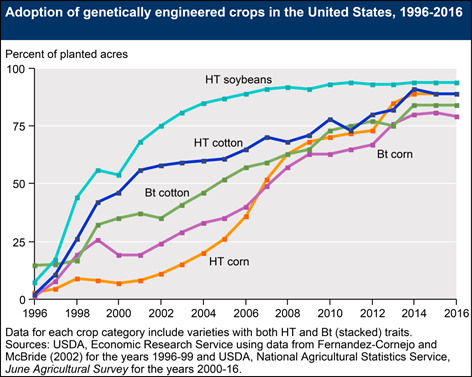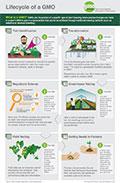Question
Answer
Expert response from Jennifer Schmidt
Maryland Farmer and Registered Dietician
Thursday, 25/05/2017 18:48
This is a simple, yet difficult question to answer because I can only answer for myself and our farming operation, and only as it applies to corn and soybeans which are the only two GMO crops we grow. We also grow non-GMO soybeans, so I have a fair comparison on cost efficiency. Our other crops – wheat, barley, green beans, tomatoes and grapes are not genetically engineered and no commercial GMO of these crops are currently on the market.
A bit of history. Our farm has always been “early adopters” of trying new systems, new technology and new approaches. One of the 1965 Farm Journal magazine editions has photos of my father-in-law on a hi-boy inter-seeder, planting cover crops and practicing no-till agriculture, which were “cutting edge” back then. We have partnered with universities, extension agents, state and national government offices, and with industry to conduct research plots on our farm to help further the knowledge agriculture has moving forward in environmental and economic sustainability. We began using biotech seeds in 1998, just two years after they were commercially available.
I’m often asked why farmers so readily adopted biotechnology and my answer is always because it was easy, since it was the next stage in improved plant breeding. Farmers had already been introduced to and adopted hybrid corn and other hybrid crops since the 1930s. That adoption curve took much longer for the majority of farmers to begin using this technology. So when genetically engineered seeds became available, it was a pretty easy next step in the decision to adopt. The other benefit is that the technology worked. When you look at the adoption curve since 1996, we would have never reached the level of the number of farmers using this technology if it hadn’t been effective and beneficial.

So to your question – are GMOs cost efficient.
I included below only soybean information because we did not grow any conventional/non-GM corn so I have no side by side comparison of GM to non-GM corn for 2016. All of the corn we grew in 2016 was "RIB" - refuge in bag, meaning a certain percentage of the seeds in the bag were non-traited/non-GM seeds to serve as an insect resistance management program. Why did we give up conventional/non-GM corn? Because there was no yield advantage and no premium associated with growing it. It didn't perform as well and as with any business owner looking at the bottom line, there was no economic or agronomic reason to continue.
|
Soybeans (dryland) |
1998 |
2000 |
2005 |
2010 (slight drought) |
2012 (drought) |
2013 |
2015 |
2016 |
|
GMO Acreage |
195 |
322 |
416 |
270 |
527 |
200 |
400 |
611 |
|
Yield BPA |
54.2 |
50.3 |
53.5 |
46 |
43 |
48 |
45 |
62 |
|
NonGMO Acreage |
156 |
184 |
213 |
306 |
675 |
175 |
200 |
182 |
|
Yield BPA |
48.2 |
43.2 |
46.3 |
36 |
36 |
25 |
34 |
42 |
|
Yield Difference |
6 |
7.1 |
7.2 |
10 |
7 |
23 |
11 |
20 |
2016 Soybean Production
|
Cost Per Acre |
Non-GMO for Food |
GMO/RR for Feed |
GMO/RR/High Oleic for Feed |
|
Seed |
$39 |
$47 |
$49 |
|
Fertilizer |
$20 |
$20 |
$20 |
|
Herbicide |
$40 |
$18.50 |
$18.50 |
|
Crop Insurance |
$37 |
$37 |
$37 |
|
Fertilizer application |
$6 |
$6 |
$6 |
|
Planting |
$15 |
$15 |
$15 |
|
Pesticide application |
$18 |
$12 |
$12 |
|
Harvest |
$28 |
$28 |
$28 |
|
Hauling |
$9 |
$9 |
$4 |
|
Land Rent |
$150 |
$150 |
$150 |
|
Total Cost of Inputs |
$362 |
$342.50 |
$339.50 |
|
Bushels/Ac (BPA) |
42 BPA |
53 BPA |
62 BPA |
|
Price/Bushel |
$11.13 |
$9.13 |
$9.63 |
|
Gross Income |
$467.50 |
$483.9 |
$597.05 |
|
Net Income Difference |
$105.5 |
$141.4 |
$257.55 |
So what's our conclusion from the 2016 data?
1. GMO continues to out yield non-GM in the 18 cropping years that we have grown it.
2. The $2/bushel premium for non-GM soybeans does not offset the yield loss for either GMO with or without a premium. Let me explain. Here on the Delmarva, we can grow high oleic (HO) soybeans and receive a 50 cent premium per bushel over commodity price. These HO beans are segregated and kept pure to their genetics just like the non-GM are segregated and kept pure to their (lack of) traits. Compared to regular Roundup Ready soybeans, the HO beans which are also Roundup ready have consistently been a higher yielding bean for us having grown them now for four years. The chart above shows that our tofu beans continue to be our lowest yielding, least profitable soybean despite the fact that there is a significant premium attached to growing it. Roundup Ready beans, while traited/GM, do not perform as well as the high oleic soybeans. For us, a nine bushel per acre difference.
3. For 2017, the majority of our acres will be high oleic soybeans. There is a huge demand and not enough acres in production for our region. The closest grain elevator to our farm is dedicated to HO beans so our trucking costs are significantly lower. We don't have to use our own storage bins so HO beans fit really well into our farming business plan. We will continue to grow tofu beans as part of a diversification effort as members of a farmer’s cooperative for the market opportunity to meet the limited customer demand for local tofu on the East Coast. Keep in mind that a lot of tofu can be made from a small number of bushels of soybeans so this is not a huge market. We sell tofu beans by the pallet, not by the truck load.
4. There is no "one" way of making decisions on a farm and what works for us may not work well for others. Much depends on how much risk someone is willing to take, how much debt they are in already, what makes sense for the number of tractors and people they have to get the various jobs done, and so many other decisions that impact whether a farm is profitable or not. I do know one thing, no child is going to come back to a farm that is deep in the red and so our choices today effect the ability for the next generation to decide to return or not. Nothing is straight forward, nothing is black or white and there is no cookie cutter method for farming across the country.
Please remember that not all farmers have the same premiums available to them, or the same market access so this data again, only applies to us and to this region.
